An official website of the United States government
 United States Department of Labor
United States Department of Labor
Clean and repair septic tanks, sewer lines, or drains. May patch walls and partitions of tank, replace damaged drain tile, or repair breaks in underground piping.
Employment estimate and mean wage estimates for Septic Tank Servicers and Sewer Pipe Cleaners:
| Employment (1) | Employment RSE (3) |
Mean hourly wage |
Mean annual wage (2) |
Wage RSE (3) |
|---|---|---|---|---|
| 27,900 | 2.8 % | $ 23.84 | $ 49,590 | 0.8 % |
Percentile wage estimates for Septic Tank Servicers and Sewer Pipe Cleaners:
| Percentile | 10% | 25% | 50% (Median) |
75% | 90% |
|---|---|---|---|---|---|
| Hourly Wage | $ 16.30 | $ 18.55 | $ 22.56 | $ 27.53 | $ 33.03 |
| Annual Wage (2) | $ 33,890 | $ 38,590 | $ 46,910 | $ 57,270 | $ 68,700 |
Industries with the highest published employment and wages for Septic Tank Servicers and Sewer Pipe Cleaners are provided. For a list of all industries with employment in Septic Tank Servicers and Sewer Pipe Cleaners, see the Create Customized Tables function.
Industries with the highest levels of employment in Septic Tank Servicers and Sewer Pipe Cleaners:
| Industry | Employment (1) | Percent of industry employment | Hourly mean wage | Annual mean wage (2) |
|---|---|---|---|---|
| Remediation and Other Waste Management Services | 15,750 | 8.73 | $ 23.19 | $ 48,220 |
| Local Government, excluding Schools and Hospitals (OEWS Designation) | 6,310 | 0.11 | $ 25.25 | $ 52,520 |
| Building Equipment Contractors | 1,810 | 0.07 | $ 25.48 | $ 52,990 |
| Other Specialty Trade Contractors | 1,610 | 0.21 | $ 23.51 | $ 48,910 |
| Utility System Construction | 560 | 0.10 | $ 26.90 | $ 55,940 |
Industries with the highest concentration of employment in Septic Tank Servicers and Sewer Pipe Cleaners:
| Industry | Employment (1) | Percent of industry employment | Hourly mean wage | Annual mean wage (2) |
|---|---|---|---|---|
| Remediation and Other Waste Management Services | 15,750 | 8.73 | $ 23.19 | $ 48,220 |
| Other Specialty Trade Contractors | 1,610 | 0.21 | $ 23.51 | $ 48,910 |
| Water, Sewage and Other Systems | 120 | 0.20 | $ 22.58 | $ 46,960 |
| Local Government, excluding Schools and Hospitals (OEWS Designation) | 6,310 | 0.11 | $ 25.25 | $ 52,520 |
| Utility System Construction | 560 | 0.10 | $ 26.90 | $ 55,940 |
Top paying industries for Septic Tank Servicers and Sewer Pipe Cleaners:
| Industry | Employment (1) | Percent of industry employment | Hourly mean wage | Annual mean wage (2) |
|---|---|---|---|---|
| Architectural, Engineering, and Related Services | (8) | (8) | $ 30.01 | $ 62,420 |
| Utility System Construction | 560 | 0.10 | $ 26.90 | $ 55,940 |
| Building Equipment Contractors | 1,810 | 0.07 | $ 25.48 | $ 52,990 |
| Local Government, excluding Schools and Hospitals (OEWS Designation) | 6,310 | 0.11 | $ 25.25 | $ 52,520 |
| Services to Buildings and Dwellings | 330 | 0.01 | $ 24.03 | $ 49,980 |
States and areas with the highest published employment, location quotients, and wages for Septic Tank Servicers and Sewer Pipe Cleaners are provided. For a list of all areas with employment in Septic Tank Servicers and Sewer Pipe Cleaners, see the Create Customized Tables function.
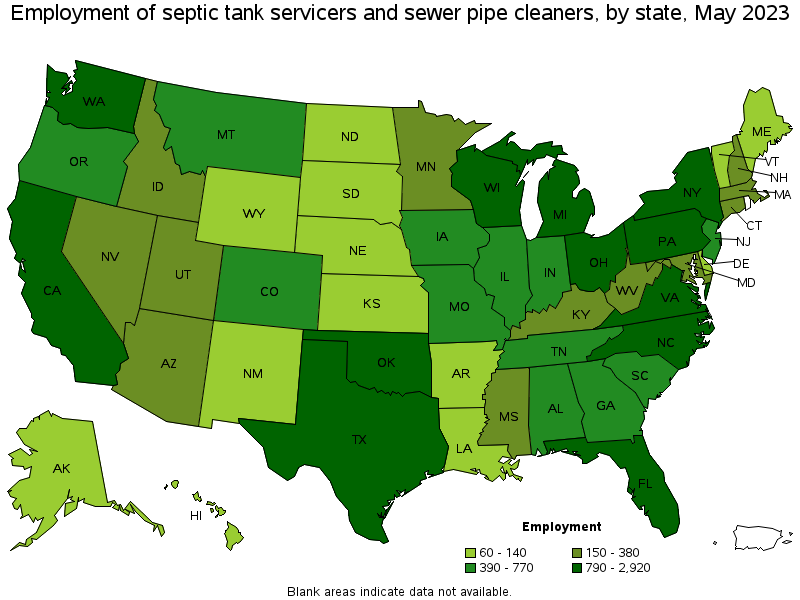
States with the highest employment level in Septic Tank Servicers and Sewer Pipe Cleaners:
| State | Employment (1) | Employment per thousand jobs | Location quotient (9) | Hourly mean wage | Annual mean wage (2) |
|---|---|---|---|---|---|
| Texas | 2,920 | 0.22 | 1.17 | $ 20.16 | $ 41,930 |
| California | 2,610 | 0.15 | 0.79 | $ 24.96 | $ 51,910 |
| New York | 1,680 | 0.18 | 0.97 | $ 24.50 | $ 50,950 |
| Washington | 1,630 | 0.47 | 2.54 | $ 29.51 | $ 61,380 |
| Michigan | 1,430 | 0.33 | 1.78 | $ 22.94 | $ 47,720 |
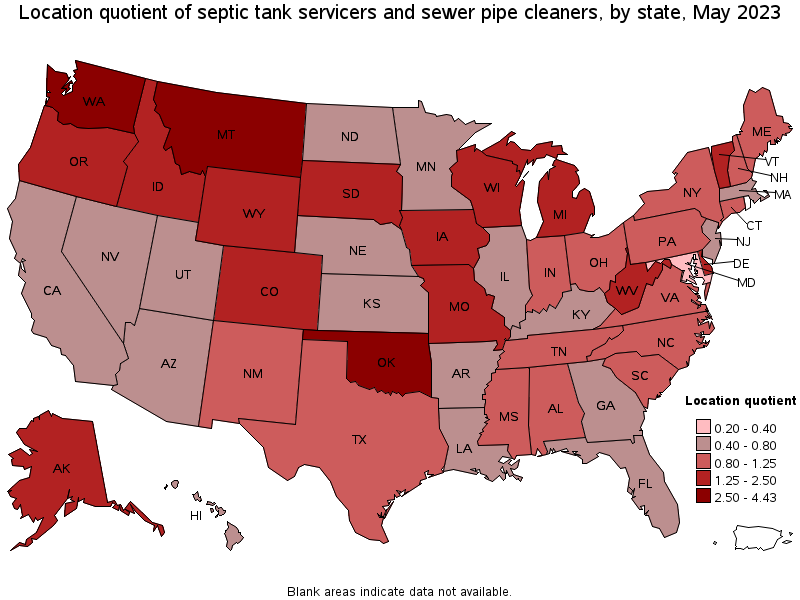
States with the highest concentration of jobs and location quotients in Septic Tank Servicers and Sewer Pipe Cleaners:
| State | Employment (1) | Employment per thousand jobs | Location quotient (9) | Hourly mean wage | Annual mean wage (2) |
|---|---|---|---|---|---|
| Montana | 410 | 0.81 | 4.43 | $ 25.75 | $ 53,570 |
| Oklahoma | 830 | 0.50 | 2.73 | $ 19.15 | $ 39,830 |
| Washington | 1,630 | 0.47 | 2.54 | $ 29.51 | $ 61,380 |
| Iowa | 640 | 0.42 | 2.26 | $ 25.15 | $ 52,310 |
| Vermont | 100 | 0.34 | 1.87 | $ 22.22 | $ 46,210 |
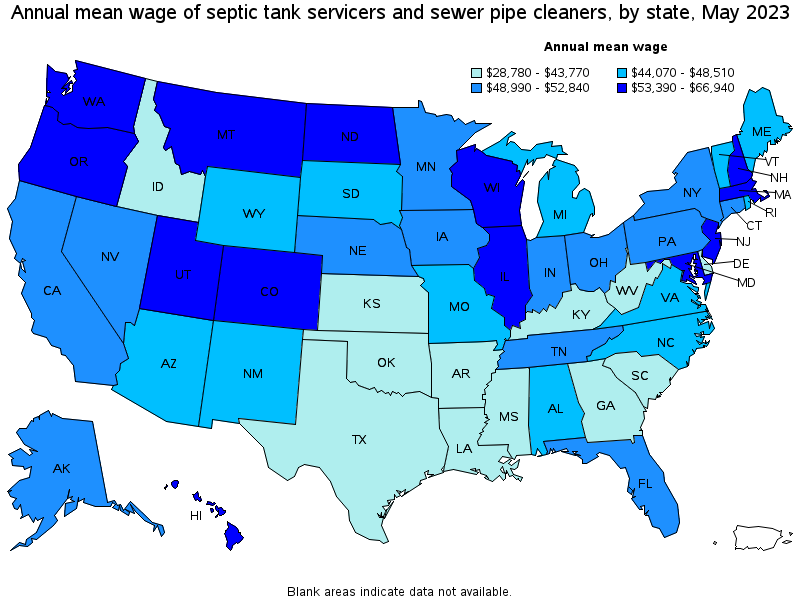
Top paying states for Septic Tank Servicers and Sewer Pipe Cleaners:
| State | Employment (1) | Employment per thousand jobs | Location quotient (9) | Hourly mean wage | Annual mean wage (2) |
|---|---|---|---|---|---|
| New Jersey | 410 | 0.10 | 0.54 | $ 32.18 | $ 66,940 |
| New Hampshire | 150 | 0.23 | 1.24 | $ 31.61 | $ 65,740 |
| Massachusetts | 330 | 0.09 | 0.49 | $ 30.80 | $ 64,070 |
| Hawaii | 70 | 0.11 | 0.59 | $ 30.68 | $ 63,810 |
| Washington | 1,630 | 0.47 | 2.54 | $ 29.51 | $ 61,380 |
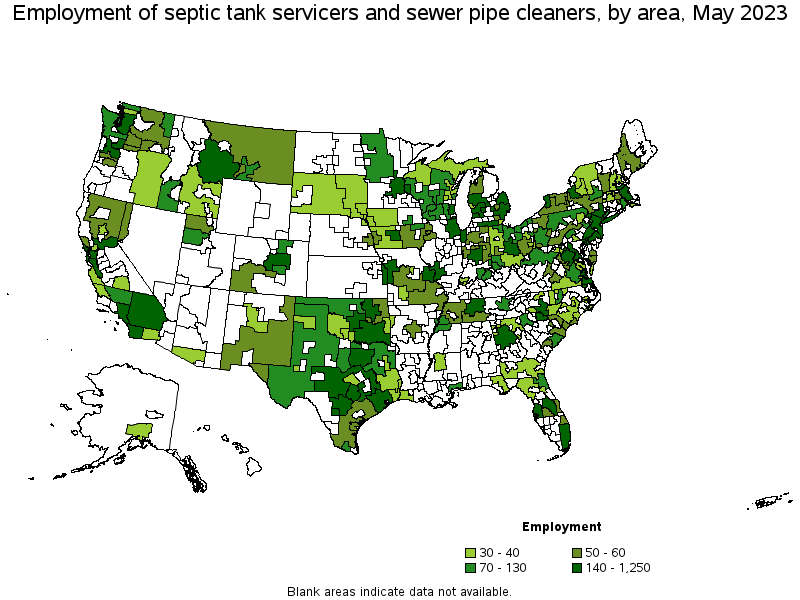
Metropolitan areas with the highest employment level in Septic Tank Servicers and Sewer Pipe Cleaners:
| Metropolitan area | Employment (1) | Employment per thousand jobs | Location quotient (9) | Hourly mean wage | Annual mean wage (2) |
|---|---|---|---|---|---|
| New York-Newark-Jersey City, NY-NJ-PA | 1,250 | 0.13 | 0.72 | $ 27.45 | $ 57,090 |
| Seattle-Tacoma-Bellevue, WA | 830 | 0.40 | 2.18 | $ 30.99 | $ 64,470 |
| Houston-The Woodlands-Sugar Land, TX | 660 | 0.21 | 1.13 | $ 21.16 | $ 44,010 |
| Los Angeles-Long Beach-Anaheim, CA | 620 | 0.10 | 0.54 | $ 23.71 | $ 49,320 |
| Dallas-Fort Worth-Arlington, TX | 600 | 0.15 | 0.83 | $ 21.66 | $ 45,060 |
| Detroit-Warren-Dearborn, MI | 580 | 0.31 | 1.68 | $ 23.34 | $ 48,540 |
| Chicago-Naperville-Elgin, IL-IN-WI | 510 | 0.11 | 0.62 | $ 27.07 | $ 56,310 |
| Philadelphia-Camden-Wilmington, PA-NJ-DE-MD | 390 | 0.14 | 0.74 | $ 25.61 | $ 53,280 |
| San Francisco-Oakland-Hayward, CA | 380 | 0.16 | 0.85 | $ 31.67 | $ 65,870 |
| Portland-Vancouver-Hillsboro, OR-WA | 330 | 0.27 | 1.50 | $ 27.88 | $ 57,980 |
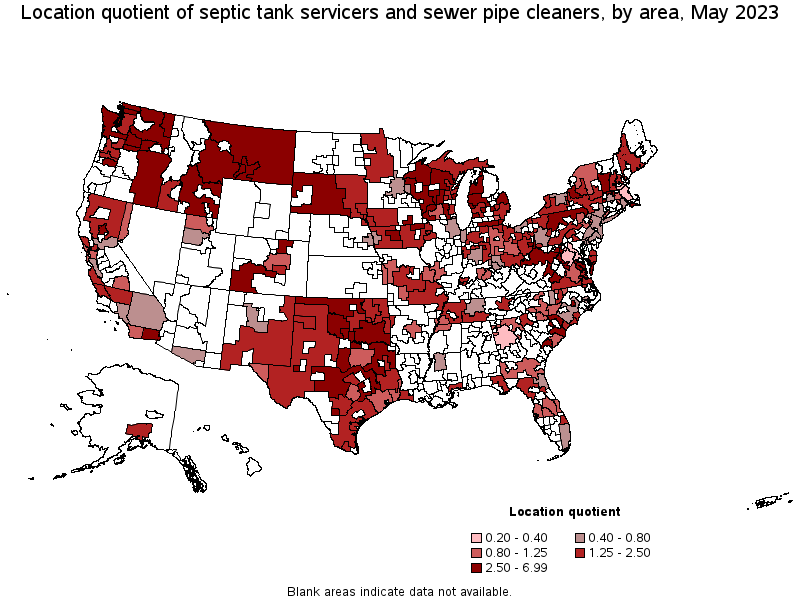
Metropolitan areas with the highest concentration of jobs and location quotients in Septic Tank Servicers and Sewer Pipe Cleaners:
| Metropolitan area | Employment (1) | Employment per thousand jobs | Location quotient (9) | Hourly mean wage | Annual mean wage (2) |
|---|---|---|---|---|---|
| Bellingham, WA | 120 | 1.28 | 6.99 | $ 31.18 | $ 64,850 |
| Albany, OR | 50 | 1.07 | 5.82 | $ 25.33 | $ 52,680 |
| Waterloo-Cedar Falls, IA | 80 | 0.96 | 5.24 | $ 25.92 | $ 53,910 |
| Goldsboro, NC | 40 | 0.90 | 4.89 | $ 20.15 | $ 41,900 |
| Monroe, MI | 30 | 0.81 | 4.44 | $ 22.75 | $ 47,320 |
| Muncie, IN | 40 | 0.81 | 4.40 | $ 25.06 | $ 52,130 |
| Mount Vernon-Anacortes, WA | 40 | 0.79 | 4.31 | $ 32.05 | $ 66,670 |
| Greeley, CO | 90 | 0.79 | 4.31 | $ 24.38 | $ 50,700 |
| Bremerton-Silverdale, WA | 70 | 0.77 | 4.19 | $ 29.07 | $ 60,460 |
| Lawton, OK | 30 | 0.75 | 4.07 | $ 18.22 | $ 37,890 |
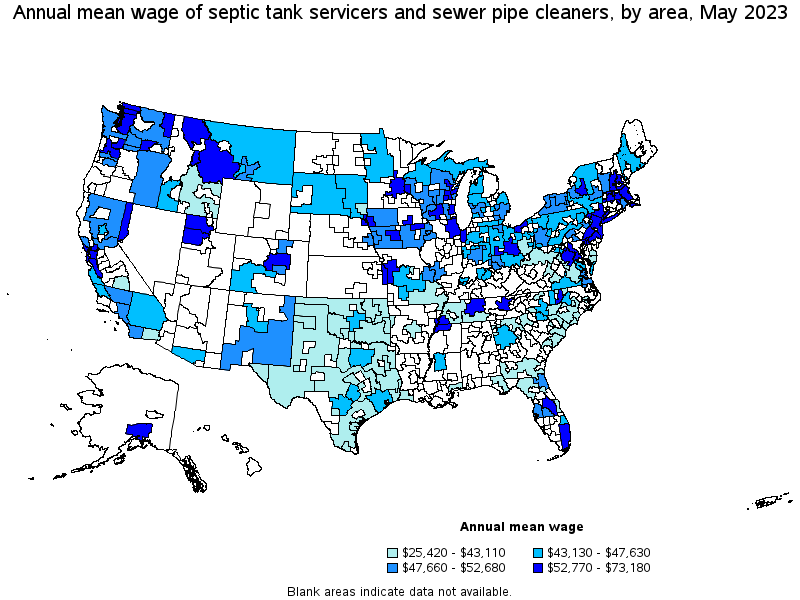
Top paying metropolitan areas for Septic Tank Servicers and Sewer Pipe Cleaners:
| Metropolitan area | Employment (1) | Employment per thousand jobs | Location quotient (9) | Hourly mean wage | Annual mean wage (2) |
|---|---|---|---|---|---|
| Durham-Chapel Hill, NC | 90 | 0.28 | 1.54 | $ 35.18 | $ 73,180 |
| Boston-Cambridge-Nashua, MA-NH | 180 | 0.07 | 0.36 | $ 32.30 | $ 67,170 |
| Mount Vernon-Anacortes, WA | 40 | 0.79 | 4.31 | $ 32.05 | $ 66,670 |
| San Francisco-Oakland-Hayward, CA | 380 | 0.16 | 0.85 | $ 31.67 | $ 65,870 |
| Bellingham, WA | 120 | 1.28 | 6.99 | $ 31.18 | $ 64,850 |
| Seattle-Tacoma-Bellevue, WA | 830 | 0.40 | 2.18 | $ 30.99 | $ 64,470 |
| Ogden-Clearfield, UT | 60 | 0.20 | 1.07 | $ 29.57 | $ 61,510 |
| Salt Lake City, UT | 100 | 0.13 | 0.71 | $ 29.23 | $ 60,800 |
| Worcester, MA-CT | 50 | 0.18 | 0.96 | $ 29.15 | $ 60,630 |
| Bremerton-Silverdale, WA | 70 | 0.77 | 4.19 | $ 29.07 | $ 60,460 |
Nonmetropolitan areas with the highest employment in Septic Tank Servicers and Sewer Pipe Cleaners:
| Nonmetropolitan area | Employment (1) | Employment per thousand jobs | Location quotient (9) | Hourly mean wage | Annual mean wage (2) |
|---|---|---|---|---|---|
| Hill Country Region of Texas nonmetropolitan area | 160 | 0.78 | 4.25 | $ 19.41 | $ 40,360 |
| Southwest Montana nonmetropolitan area | 150 | 1.02 | 5.58 | $ 27.97 | $ 58,170 |
| Southeast Oklahoma nonmetropolitan area | 150 | 0.90 | 4.87 | $ 18.67 | $ 38,830 |
| Balance of Lower Peninsula of Michigan nonmetropolitan area | 140 | 0.53 | 2.88 | $ 21.11 | $ 43,920 |
| North Texas Region of Texas nonmetropolitan area | 130 | 0.48 | 2.62 | $ 19.41 | $ 40,360 |
Nonmetropolitan areas with the highest concentration of jobs and location quotients in Septic Tank Servicers and Sewer Pipe Cleaners:
| Nonmetropolitan area | Employment (1) | Employment per thousand jobs | Location quotient (9) | Hourly mean wage | Annual mean wage (2) |
|---|---|---|---|---|---|
| Northwest Oklahoma nonmetropolitan area | 110 | 1.11 | 6.03 | $ 19.61 | $ 40,790 |
| Southwest Montana nonmetropolitan area | 150 | 1.02 | 5.58 | $ 27.97 | $ 58,170 |
| Southeast Oklahoma nonmetropolitan area | 150 | 0.90 | 4.87 | $ 18.67 | $ 38,830 |
| Western Washington nonmetropolitan area | 110 | 0.82 | 4.48 | $ 25.09 | $ 52,180 |
| Northwest Virginia nonmetropolitan area | 50 | 0.79 | 4.29 | $ 18.61 | $ 38,700 |
Top paying nonmetropolitan areas for Septic Tank Servicers and Sewer Pipe Cleaners:
| Nonmetropolitan area | Employment (1) | Employment per thousand jobs | Location quotient (9) | Hourly mean wage | Annual mean wage (2) |
|---|---|---|---|---|---|
| Massachusetts nonmetropolitan area | 30 | 0.49 | 2.66 | $ 34.26 | $ 71,250 |
| Central New Hampshire nonmetropolitan area | 30 | 0.37 | 2.03 | $ 31.44 | $ 65,400 |
| West Central-Southwest New Hampshire nonmetropolitan area | 40 | 0.36 | 1.97 | $ 29.32 | $ 60,990 |
| Southwest Montana nonmetropolitan area | 150 | 1.02 | 5.58 | $ 27.97 | $ 58,170 |
| West Montana nonmetropolitan area | (8) | (8) | (8) | $ 26.19 | $ 54,470 |
These estimates are calculated with data collected from employers in all industry sectors, all metropolitan and nonmetropolitan areas, and all states and the District of Columbia. The top employment and wage figures are provided above. The complete list is available in the downloadable XLS files.
The percentile wage estimate is the value of a wage below which a certain percent of workers fall. The median wage is the 50th percentile wage estimate—50 percent of workers earn less than the median and 50 percent of workers earn more than the median. More about percentile wages.
(1) Estimates for detailed occupations do not sum to the totals because the totals include occupations not shown separately. Estimates do not include self-employed workers.
(2) Annual wages have been calculated by multiplying the hourly mean wage by a "year-round, full-time" hours figure of 2,080 hours; for those occupations where there is not an hourly wage published, the annual wage has been directly calculated from the reported survey data.
(3) The relative standard error (RSE) is a measure of the reliability of a survey statistic. The smaller the relative standard error, the more precise the estimate.
(8) Estimate not released.
(9) The location quotient is the ratio of the area concentration of occupational employment to the national average concentration. A location quotient greater than one indicates the occupation has a higher share of employment than average, and a location quotient less than one indicates the occupation is less prevalent in the area than average.
Other OEWS estimates and related information:
May 2023 National Occupational Employment and Wage Estimates
May 2023 State Occupational Employment and Wage Estimates
May 2023 Metropolitan and Nonmetropolitan Area Occupational Employment and Wage Estimates
May 2023 National Industry-Specific Occupational Employment and Wage Estimates
Last Modified Date: April 3, 2024